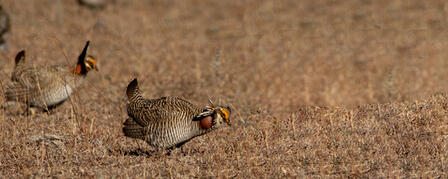LESSER PRAIRIE-CHICKEN ADDED TO FEDERAL LIST OF THREATENED SPECIES

March 28, 2014
Kansas Department of Wildlife, Parks and Tourism disappointed in decision
TOPEKA– Kansas Department of Wildlife, Parks and Tourism (KDWPT) Secretary Robin Jennison reacted with disappointment over the U.S. Fish and Wildlife Service’s decision Thursday to list the lesser prairie-chicken as threatened. Dan Ash, director of the U.S. Fish and Wildlife Service (USFWS), announced the decision last Thursday, citing habitat fragmentation, population declines, drought, and threats from development.
“This wasn’t the decision we hoped to hear,” Jennison said. “A lot of work went into a plan to show that state wildlife agencies could manage and conserve lesser prairie chickens without designating the species as threatened.”
For the past 18 months, KDWPT participated in the Lesser Prairie-Chicken Interstate Working Group, established by the Western Association of Fish and Wildlife Agencies (WAFWA). Wildlife biologists from agencies in Kansas, Texas, Oklahoma, New Mexico and Texas, as well as other partners, worked tirelessly to develop a Range-wide Lesser Prairie Chicken Plan (RWP) to conserve the species. Keith Sexson, KDWPT assistant secretary, was actively involved in the process and is pleased with the way state agencies worked together.
“The feeling among state wildlife agencies was that such a plan would benefit lesser prairie chickens through voluntary support from industry and private landowners, and perhaps dissuade the USFWS from listing the species,” said Sexson, KDWPT assistant secretary. “I’m proud of the effort and passion shown by our staff to help create this plan, and it demonstrates the ability for state fish and wildlife agencies to work together with industry and private landowners to deliver an approach that will result in positive conservation for the lesser prairie-chicken.”
While the USFWS endorsed the final version of the conservation plan, it didn’t prevent the final listing of the species.
“I believe the development and initial success of the range-wide plan shows that our staff have the expertise necessary to manage lesser prairie chickens and their habitats. I think we missed an opportunity to break out of the status quo in managing species in need of conservation,” Jennison said. “Had the final decision been ‘not warranted,’ the range-wide plan would have represented a groundbreaking new approach for the way these decisions are made. We have a plan that would have conserved prairie chickens and benefitted all stakeholders without the burdensome red tape and often times heavy-handed approach of the federal government.”
The final RWP is the result of an unprecedented effort and collaboration among state agencies, landowners and industry. The RWP is a comprehensive lesser prairie chicken conservation/management plan that provides a vehicle to bring industry, government and private landowners together to conserve the lesser prairie-chicken and its habitat. To date, more than $20 million has been committed by oil, gas, wind and electric transmission industries that will impact nearly 4 million acres, enhancing and developing critical lesser prairie-chicken habitat.
Information about the RWP is available on the WAFWA website, www.wafwa.org.
-30-









